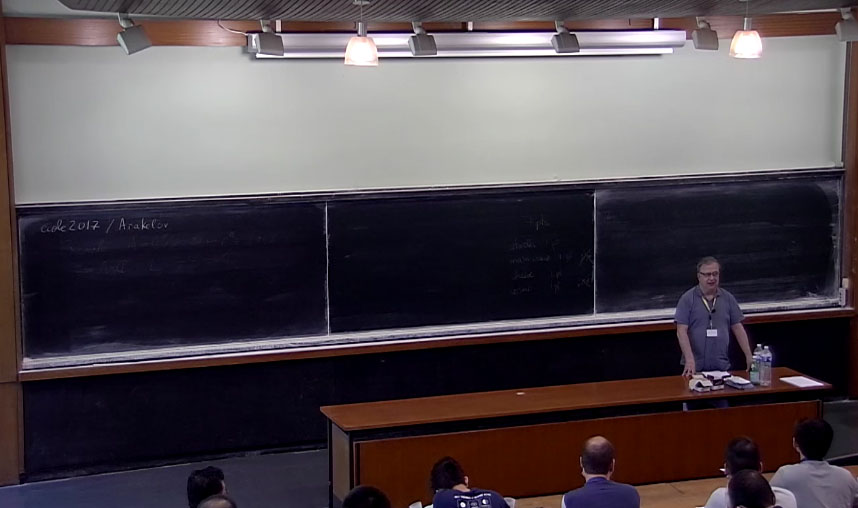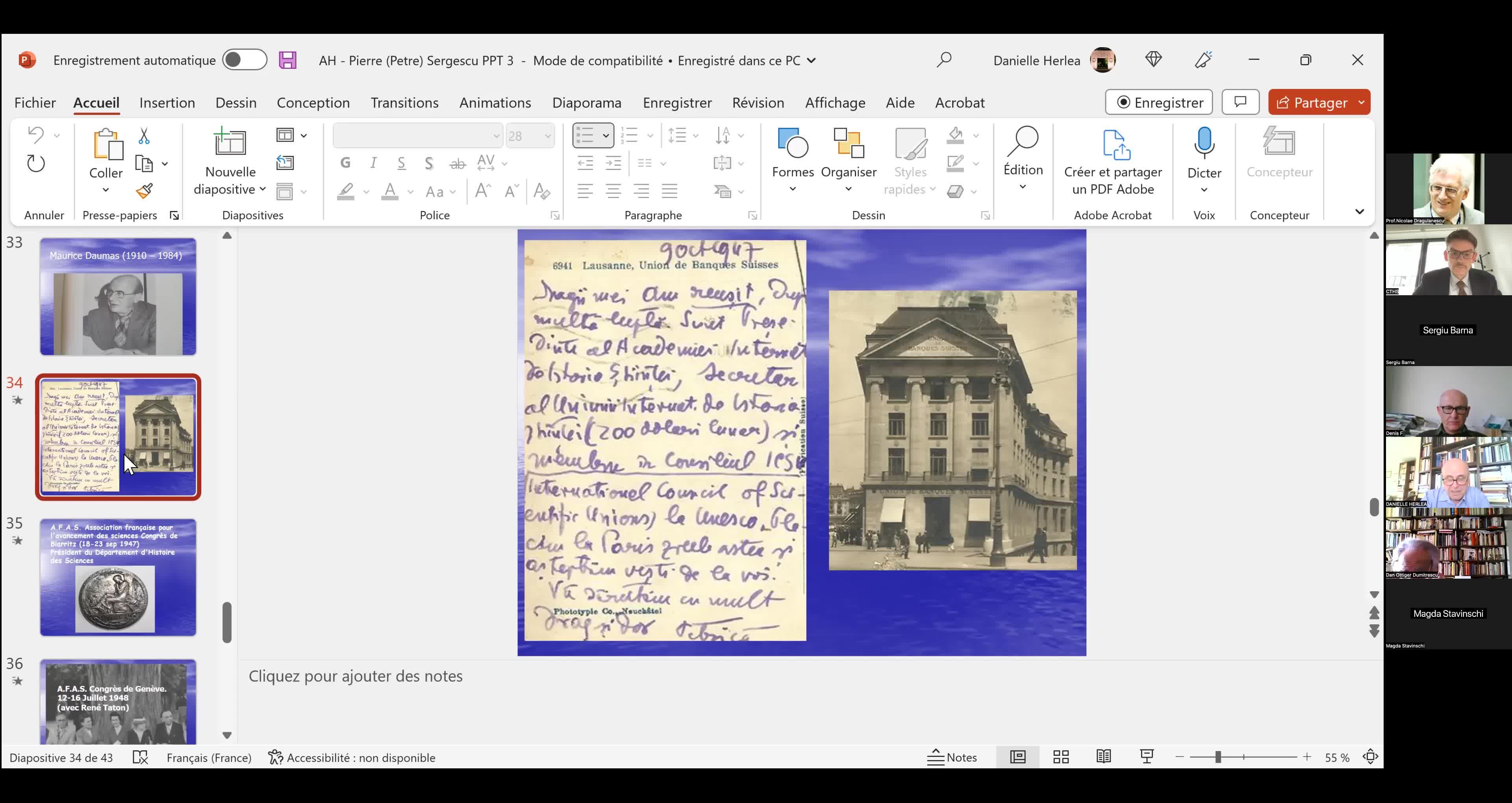Notice
J. Bruinier et J. Ignacio Burgos Gil - Arakelov theory on Shimura varieties (part2)
- document 1 document 2 document 3
- niveau 1 niveau 2 niveau 3
Descriptif
A Shimura variety is a higher-dimensional analogue of a modular curve that arises as a quotient of a Hermitian symmetric space by a congruence subgroup of a reductive algebraic group defined over Q. Shimura varieties have a very rich geometric and arithmetic structure. For instance they are defined over a number field (the reflex field), they have line bundles provided with hermitian metrics that come from a representation of a maximal compact subgroup and sometimes they have models over a localization of a ring of integers coming from a modular interpretation.
Open Shimura varieties admit toroidal compactifications, but the mentioned metrized line bundles do not extend to a smoothly metrized line bundle in the compactification, but to a line bundles with logarithmic singular metric. Thus the usual Arakelov geometry can not be applied to them. In this course we will explain how to extend Arakelov theory to cover this class of singular metrics.
Important applications of this extended Arakelov theory arise in the context of the Kudla program, which predicts deep connections between the arithmetic geometry of arithmetic special cycles on integral models of orthogonal and unitary Shimura varieties and the theory of Siegel modular forms. These connections lead to (often conjectural) generalizations of results of Gross, Kohnen and Zagier on Heegner divisors on modular curves. We will give an introduction to the Kudla program and discuss some cases where the predictions have been proved.
Intervention
Thème
Documentation
Dans la même collection
-
X. Yuan - On the arithmetic degree of Shimura curves
YUAN Xinyi
The goal of this talk is to introduce a Gross--Zagier type formula, which relates the arithmetic self-intersection number of the Hodge bundle of a quaternionic Shimura curve over a totally real
-
Y. Tang - Exceptional splitting of reductions of abelian surfaces with real multiplication
TANG Yunqing
Chavdarov and Zywina showed that after passing to a suitable field extension, every abelian surface A with real multiplication over some number field has geometrically simple reduction modulo p
-
A. von Pippich - An analytic class number type formula for PSL2(Z)
PIPPICH Anna-Maria von
For any Fuchsian subgroup Γ⊂PSL2(R) of the first kind, Selberg introduced the Selberg zeta function in analogy to the Riemann zeta function using the lengths of simple closed geodesics on Γ∖H
-
Z. Huang - Diophantine approximation and local distribution of rational points
HUANG Zhizhong
We show how to use the recent work of D. McKinnon and M. Roth on generalizations of Diophantine approximation to algebraic varieties to formulate a local version of the Batyrev-Manin principle on
-
C. Soulé - Arithmetic Intersection (Part4)
SOULé Christophe
Let X be a 2-dimensional, normal, flat, proper scheme over the integers. Assume ¯L and ¯M are two hermitian line bundles over X. Arakelov (and Deligne) defined a real number ¯L.¯M, the arithmetic
-
C. Soulé - Arithmetic Intersection (Part1)
SOULé Christophe
Let X be a 2-dimensional, normal, flat, proper scheme over the integers. Assume ¯L and ¯M are two hermitian line bundles over X. Arakelov (and Deligne) defined a real number ¯L.¯M, the arithmetic
-
C. Soulé - Arithmetic Intersection (Part3)
SOULé Christophe
Let X be a 2-dimensional, normal, flat, proper scheme over the integers. Assume ¯L and ¯M are two hermitian line bundles over X. Arakelov (and Deligne) defined a real number ¯L.¯M, the arithmetic
-
P. Salberger - Quantitative aspects of rational points on algebraic varieties (part4)
SALBERGER Per
Let X be a subvariety of Pn defined over a number field and N(B) be the number of rational points of height at most B on X. There are then general conjectures of Manin on the asymptotic behaviour
-
C. Soulé - Arithmetic Intersection (Part2)
SOULé Christophe
Let X be a 2-dimensional, normal, flat, proper scheme over the integers. Assume ¯L and ¯M are two hermitian line bundles over X. Arakelov (and Deligne) defined a real number ¯L.¯M, the arithmetic
-
D. Loughran - Sieving rational points on algebraic varieties
LOUGHRAN Daniel
Sieves are an important tool in analytic number theory. In a typical sieve problem, one is given a list of p-adic conditions for all primes p, and the challenge is to count the number of integers
-
E. Peyre - Slopes and distribution of points (part4)
PEYRE Emmanuel
The distribution of rational points of bounded height on algebraic varieties is far from uniform. Indeed the points tend to accumulate on thin subsets which are images of non-trivial finite
-
P. Salberger - Quantitative aspects of rational points on algebraic varieties (part2)
SALBERGER Per
Let X be a subvariety of Pn defined over a number field and N(B) be the number of rational points of height at most B on X. There are then general conjectures of Manin on the asymptotic behaviour
Avec les mêmes intervenants et intervenantes
-
J. Bruinier et J. Ignacio Burgos Gil - Arakelov theory on Shimura varieties (part1)
BRUINIER Jan Hendrik
BURGOS GIL José Ignacio
A Shimura variety is a higher-dimensional analogue of a modular curve that arises as a quotient of a Hermitian symmetric space by a congruence subgroup of a reductive algebraic group defined over
Sur le même thème
-
"Le mathématicien Petre (Pierre) Sergescu, historien des sciences, personnalité du XXe siècle"
HERLéA Alexandre
Alexandre HERLEA est membre de la section « Sciences, histoire des sciences et des techniques et archéologie industrielle » du CTHS. Professeur émérite des universités, membre effectif de l'Académie
-
Webinaire sur la rédaction des PGD
LOUVET Violaine
Rédaction des Plans de Gestion de Données (PGD) sous l’angle des besoins de la communauté mathématique.
-
Alexandre Booms : « Usage de matériel pédagogique adapté en géométrie : une transposition à interro…
« Usage de matériel pédagogique adapté en géométrie : une transposition à interroger ». Alexandre Booms, doctorant (Université de Reims Champagne-Ardenne - Cérep UR 4692)
-
A. Mondino - Time-like Ricci curvature bounds via optimal transport
MONDINO Andrea
The goal of the talk is to present a recent work in collaboration with Cavalletti (SISSA) on optimal transport in Lorentzian synthetic spaces. The aim is to set up a “Lorentzian analog” of the
-
M. Lesourd - Positive Scalar Curvature on Noncompact Manifolds and the Positive Mass Theorem
LESOURD Martin
The study of positive scalar curvature on noncompact manifolds has seen significant progress in the last few years. A major role has been played by Gromov's results and conjectures, and in
-
R. Perales - Recent Intrinsic Flat Convergence Theorems
PERALES Raquel
Théorèmes récents de convergence plane intrinsèque
-
J. Fine - Knots, minimal surfaces and J-holomorphic curves
FINE Joël
I will describe work in progress, parts of which are joint with Marcelo Alves. Let L be a knot or link in the 3-sphere. I will explain how one can count minimal surfaces in hyperbolic 4-space
-
J. Wang - Topological rigidity and positive scalar curvature
WANG Jian
In this talk, we shall describe some topological rigidity and its relationship with positive scalar curvature. Precisely, we will present a proof that a complete contractible 3-manifold with
-
D. Semola - Boundary regularity and stability under lower Ricci bounds
SEMOLA Daniele
The theory of non smooth spaces with lower Ricci Curvature bounds has undergone huge developments in the last thirty years. On the one hand the impetus came from Gromov’s precompactness theorem
-
D. Stern - Harmonic map methods in spectral geometry
STERN Daniel
Over the last fifty years, the problem of finding sharp upper bounds for area-normalized Laplacian eigenvalues on closed surfaces has attracted the attention of many geometers, due in part to
-
R. Bamler - Compactness and partial regularity theory of Ricci flows in higher dimensions
BAMLER Richard H.
We present a new compactness theory of Ricci flows. This theory states that any sequence of Ricci flows that is pointed in an appropriate sense, subsequentially converges to a synthetic flow.
-
P. Burkhardt - Pointwise lower scalar curvature bounds for C0 metrics via regularizing Ricci flow
BURKHARDT-GUIM Paula
We propose a class of local definitions of weak lower scalar curvature bounds that is well defined for C0 metrics. We show the following: that our definitions are stable under greater-than-second


























